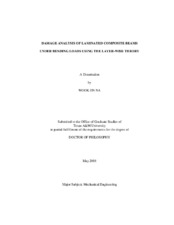| dc.contributor.advisor | Reddy, J. N. | |
| dc.creator | Na, Wook Jin | |
| dc.date.accessioned | 2010-01-15T00:13:12Z | |
| dc.date.accessioned | 2010-01-16T00:55:56Z | |
| dc.date.available | 2010-01-15T00:13:12Z | |
| dc.date.available | 2010-01-16T00:55:56Z | |
| dc.date.created | 2008-05 | |
| dc.date.issued | 2009-05-15 | |
| dc.identifier.uri | https://hdl.handle.net/1969.1/ETD-TAMU-2774 | |
| dc.description.abstract | A finite element model based on the layer-wise theory and the von Kármán type
nonlinear strains is used to analyze damage in laminated composite beams. In the
formulation, the Heaviside step function is employed to express the discontinuous
interlaminar displacement field at the delaminated interfaces. Two types of the most
common damage modes in composite laminates are investigated for cross-ply laminated
beams using a numerical approach.
First, a multi-scale analysis approach to determine the influence of transverse
cracks on a laminate is proposed. In the meso-scale model, the finite element model
based on the classical laminate theory provides the material stiffness reduction in terms
of the crack density by computing homogenized material properties of the cracked ply.
The multiplication of transverse cracks is predicted in a macro-scale beam model under
bending loads. In particular, a damage analysis based on nonlinear strain fields in
contrast to the linear case is carried out for a moderately large deformation. Secondly, the effect of delamination in a cross-ply laminated beam under
bending loads is studied for various boundary conditions with various cross-ply laminate
lay-ups. The crack growth of delamination is predicted through investigating the strain
energy release rate.
Finally, the interactions of a transverse crack and delamination are considered for
beams of different configurations. The relationships between the two different damage
modes are described through the density of intralaminar cracks and the length of the
interlaminar crack.
It is found that geometric nonlinearity plays an important role in progression of
interlaminar cracks whereas growth of intralaminar cracks is not significantly influenced.
This study also shows that the mixture of fracture mode I and II should be considered for
analysis of delamination under bending loads and the fracture mode leading
delamination changes as the damage develops. The growth of delamination originated
from the tip of the transverse crack is found to strongly depend on the thickness of 90-
degree layers as well as the transverse crack density. Further, the effect of interfacial
crack growth on the transverse cracking can be quatitatively determined by the
delamination length, the thickness of 90-degree layers and the transverse crack density. | en |
| dc.format.medium | electronic | en |
| dc.format.mimetype | application/pdf | |
| dc.language.iso | en_US | |
| dc.subject | Damage | en |
| dc.subject | Laminated Composite | en |
| dc.subject | Layer-Wise Theory | en |
| dc.subject | Bending Loads | en |
| dc.title | Damage analysis of laminated composite beams under bending loads using the layer-wise theory | en |
| dc.type | Book | en |
| dc.type | Thesis | en |
| thesis.degree.department | Mechanical Engineering | en |
| thesis.degree.discipline | Mechanical Engineering | en |
| thesis.degree.grantor | Texas A&M University | en |
| thesis.degree.name | Doctor of Philosophy | en |
| thesis.degree.level | Doctoral | en |
| dc.contributor.committeeMember | Hogan, Harry A. | |
| dc.contributor.committeeMember | Suh, Steve | |
| dc.contributor.committeeMember | Talreja, Ramesh R. | |
| dc.contributor.committeeMember | Walton, Jay R. | |
| dc.type.genre | Electronic Dissertation | en |
| dc.type.material | text | en |
| dc.format.digitalOrigin | born digital | en |


